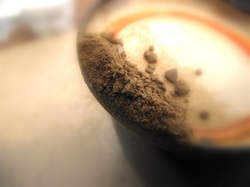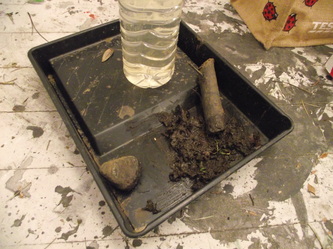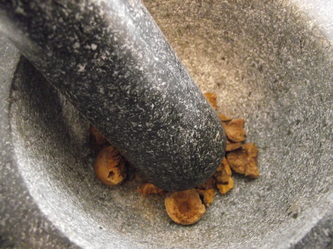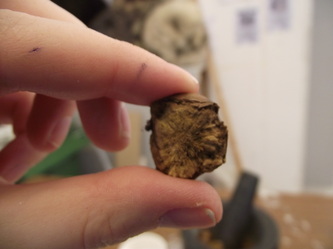Interdisciplinary Fine Artist
[email protected]
Natural Forms
I work with natural forms such as leaves, mud, twigs and river water, instead of conventional art materials like paintbrushes and manufactured paints, for instance. This is done intentionally to ensure that my work is kept as natural as possible, which inevitably reflects the theme which I am currently working with.
Oak Galls and Oak Gall Ink
Oak galls (also known as oak apples) are the result of swellings on oak trees, caused by natural reactions to the attacks of parasites, such as the gall wasp.
Oak galls look like small brown balls, which in appearance, are similar to nuts, but more spherical in comparison. They are found attached to the branches of oak apple trees during the autumnal season. Additionally, the oak gall is very light in weight.
Each individual oak gall contains fibres that are rich in gallotannic acid. When gallotannic acid is combined with warm water, it becomes tannic acid. This tannic acid, when combined with iron, becomes oak gall ink. Iron is absolutely crucial to the reaction, because it causes the tannic acid to be released, which is the most essential element in oak gall ink.
For many centuries, oak gall ink has been used to preserve and transmitt the worlds knowledge. The ink bites into paper, like an acid, and is virtually everlasting.
Oak gall ink is waterproof, and over time, becomes darker with age. However, it becomes unusable after a few weeks, so I made small quantities of ink on a regular basis.
Making Oak Gall Ink
Making oak gall ink is a very simple process. Once I collected a large quantity of oak galls, I began crushing them down with a pestle and mortar, as shown in the images opposite. At first, the oak galls broke down into small pieces, but then gradually, a sandy powder emerged. This sandy powder contains gallotannic acid required for oak gall ink.This was carried out untill I ended up with a very fine powder.
Next I covered the crushed oak galls with boiling water. While the water was cooling, I soaked a handful of iron nails in vinegar overnight. The vinegar then rusts the iron and becomes completely discolored. When the oak gall liquid cooled, I drained them through a cheesecloth and sieve. This is done because only the liquid is required for the oak gall ink. Finally I combined the oak gall liquid with the liquid from the rusty iron nails.
Preparing the Oak Gall Ink
Once the oak gall ink was produced, I began adding different substances to it in order to make it darker, because initially the ink is very light in appearance. For example, I burnt parchment paper and placed the ash into the mixture. I also added a small quantity of indian ink into the mixture, on occassions. Additionally gum arabic was also added to the oak gall ink on a frequent basis because it is a binding agent, which keeps components parts from seperating out in the ink.
Oak galls look like small brown balls, which in appearance, are similar to nuts, but more spherical in comparison. They are found attached to the branches of oak apple trees during the autumnal season. Additionally, the oak gall is very light in weight.
Each individual oak gall contains fibres that are rich in gallotannic acid. When gallotannic acid is combined with warm water, it becomes tannic acid. This tannic acid, when combined with iron, becomes oak gall ink. Iron is absolutely crucial to the reaction, because it causes the tannic acid to be released, which is the most essential element in oak gall ink.
For many centuries, oak gall ink has been used to preserve and transmitt the worlds knowledge. The ink bites into paper, like an acid, and is virtually everlasting.
Oak gall ink is waterproof, and over time, becomes darker with age. However, it becomes unusable after a few weeks, so I made small quantities of ink on a regular basis.
Making Oak Gall Ink
Making oak gall ink is a very simple process. Once I collected a large quantity of oak galls, I began crushing them down with a pestle and mortar, as shown in the images opposite. At first, the oak galls broke down into small pieces, but then gradually, a sandy powder emerged. This sandy powder contains gallotannic acid required for oak gall ink.This was carried out untill I ended up with a very fine powder.
Next I covered the crushed oak galls with boiling water. While the water was cooling, I soaked a handful of iron nails in vinegar overnight. The vinegar then rusts the iron and becomes completely discolored. When the oak gall liquid cooled, I drained them through a cheesecloth and sieve. This is done because only the liquid is required for the oak gall ink. Finally I combined the oak gall liquid with the liquid from the rusty iron nails.
Preparing the Oak Gall Ink
Once the oak gall ink was produced, I began adding different substances to it in order to make it darker, because initially the ink is very light in appearance. For example, I burnt parchment paper and placed the ash into the mixture. I also added a small quantity of indian ink into the mixture, on occassions. Additionally gum arabic was also added to the oak gall ink on a frequent basis because it is a binding agent, which keeps components parts from seperating out in the ink.





